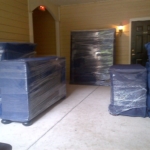With each installment, we tend to look at various aspects of your long distance move, pinpointing certain problems that you are bound to encounter, from packing to pickup. Today is more of an overview of the process, looking at the big picture, hopefully allowing you to see and recognize the scope of what you
are undertaking.
For starters, it is never too early to get things moving. Packing is a long, often arduous process that requires careful planning and proper execution. Few things disrupt any moving project quite like a frenzied packing up process right at the last minute. You also want to go through your belongings ahead of time and get rid of anything and everything that you absolutely don’t need to take with you. Go through everything at least twice, as the more you look at something, the more likely you are to make a different determination as to its necessity. The more weight you shed, the more cost efficient your move will be.
Make detailed labels. Mark down the room the box belongs in along with the contents of said box. You’ll be surprised at how much smoother your unpacking goes. When packing, finish one room before moving to the next. Put small boxes into bigger boxes. This keeps the smaller boxes from vanishing into thin air. Let everything be done decently and in proper order, thus avoiding headaches at the end of the long road.
Important documents and financial information should be taken with you, preferably on your person. You might also want to transport certain valuable items yourself. I know I have several pieces that I would not trust to anybody. If it is going to get broken, I’d rather it be my fault. Does that make sense?
Pack essential items into one box and mark it clearly. These are items such as clothing, toiletries, etc, that you may need for your first couple of nights in the new home while everything else is being sorted out.
Finally, inventory. I know, “inventory” is ten of the most boring words in the English language, but by making a list of every item and where it goes, you will instantly know if something is missing or misplaced. You can also make notes of any and all damages that may occur during the move.
So there you have it. In the coming days we will look at each of these steps more closely, fine tuning the move like a well-oiled machine. Or something like that.






